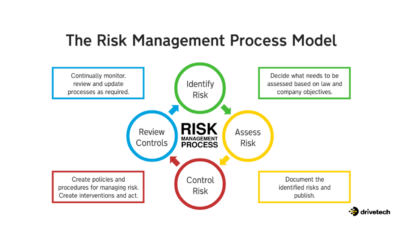Earth Day 2025
Earth day is a global event which aims to highlight the importance of protecting the environment, first set up in 1970. This ...
Read MoreNick Butler, director of Drivetech, discusses the importance of quantifying and managing road risk while travelling to work.

We’re all aware of the legal and duty of care requirements that driving for work entails, but what’s the best way of approaching this and ensuring compliance?
Implementing solutions without a deep understanding of the issues relevant to your individual organisation is ineffective and inefficient. Gaining visibility of your company’s individual risk profile and quantify each risk will make deciding on appropriate, proportionate, and effective solutions more straightforward. It’s time to take control of road risk.
Driving for work is one of the most dangerous daily activities an employee can undertake. With more deaths occurring from at-work road trips than at the workplace itself, a study on behalf of National Highways and the charitable partnership RoadSafe (2022) found that nearly one third (29%) of all road fatalities and 21% of all casualties occur in driving-for-work collisions. All road deaths are preventable and, as employers, we all have an obligation to bring these stark figures down – which we can with better risk management.
The Health and Safety Executive (HSE 2014) is clear on an employer’s obligations: “Health and Safety at Work Act 1974 requires employers to take appropriate steps to ensure the health and safety of their employees and others who may be affected by their activities when at work. There will always be risks associated with driving. Although these cannot be completely controlled, an employer has a responsibility to take all reasonable steps to manage these risks and do everything reasonably practicable to protect people from harm in the same way as they would in the workplace.”
Navigating an evolving landscape
While our obligations as employers are clear, the environment in which we operate isn’t always straightforward. We’re experiencing a huge amount of change as our economic and automotive landscape rapidly evolves. For example, we’re seeing a substantial increase in the use of light commercial vehicles for home delivery (higher mileage drivers) and a general reduction in the number of company cars.
Many people now work from home most of the week and are taking advantage of salary sacrifice schemes to purchase a vehicle (lower mileage drivers) or are part of the grey fleet (personal vehicles being used for business). In fact, according to the Office for National Statistics, around 40% of working adults reported having worked from home at some point in the past seven days (Feb 2023).
Each driver experiences their own level of risk but gone are the days when you could approach this as a one-size-fits-all. So, how do we measure and quantify the risk for these different driver types and offer tailored and therefore more effective solutions?
It’s important to take a holistic approach, looking at the full range of driver circumstances before acting. Once you have a complete picture of your fleet profile and related risk, you can follow this up with a blended range of assessments and interventions that meet your specific requirements.
Four steps to taking control
There are four steps you can follow to ensure you direct your resources effectively (see fig 1 The Risk Management Process Model).

Step 1: Identify and analyse how you manage occupational road risk
Knowledge is power. Begin the process with an audit of your organisation’s ‘driving for work’ activities, this should include the following types of measure:
How many vehicles and what type?
• How and where are they used?
• Are they fit for purpose?
• What type of incidents occur and how many?
• What policies and procedures do you have for safe working when driving?
• How experienced are those who drive for work?
• Are there wellbeing concerns around your drivers?
• Is the employee fit to drive for work?
Step 2: Assess risk
Firstly, decide who to assess. It is considered that higher mileage drivers should take priority when it comes to assessing risk, as the risk of fatigue related incidents is
extremely high. However, we also see evidence for increased risk where people drive much less frequently. People who drive for work experience stress in two key areas: when under time pressure and when driving in unfamiliar circumstances.
It’s likely that all drivers should be assessed but may require different assessment types depending on the activity. The most powerful and compelling evidence for risk lies in the employee’s own driving behaviour and history.
Assessment types
Objective assessment:
When assessing risk, evidence shows these points are the greatest predictors of increased road risk:
• Driving licence check – most drivers with endorsements are repeat offenders
• Driver incident history – often a predictor for further incidents
• Telemetry data – real time and ongoing observation of driving style; recording incidents such as speeding, harsh acceleration, cornering, and braking
Subjective assessment:
This type of assessment is useful for evaluating your employees’ road safety knowledge and gaining insight into their attitudes:
• Knowledge assessment – this assesses road and vehicle knowledge
Psychometric assessment – measures the worker’s attitude towards risk
Step 3: Controlling the risk
Now you can see and understand your risk profile you can choose how to intervene to mitigate risks appropriately. Where a lack of knowledge or poor attitude towards the subject is discovered, there are a range of interventions to address the issues. A blended approach, offering eLearning modules, workshops and webinars is shown to be effective at lowering risk and demonstrating your duty of care as an employer.
High risk drivers could represent up to 10% of your driver population Where there is a combination of high-risk results from a variety of inputs such as licence, telematics and psychometric assessment, there’s no substitute for on-road training. Moreover, when an attitude problem is present in a high-risk driver, this must be addressed urgently with a skilled trainer.
A professional trainer will help the employee realise the potential impact of the risk and encourage them to strive for better driving without compromising core safety and personal values.
Step 4: Monitor and review
Be sure to regularly monitor and review progress whilst maintaining your process of assessment and interventions. This will allow you to see what’s working and what’s not and adjust your programme accordingly:
• Keep a record of data showing which interventions are most effective, giving you return on investment.
• Be prepared to change processes if they aren’t working.
Benefits
As well as ensuring legal compliance, proactively managing and reducing your on-road risk has business-wide benefits:
• Saves lives – driving safely lowers the likelihood of being involved in a collision making our roads safer for all.
• Saves money – fewer accidents equal lower repair costs and less vehicle downtime.
• Protects your reputation – unsafe driving, particularly in branded vehicles can be damaging to a company’s image. Upskilling and coaching drivers will mitigate this risk and help protect vulnerable road users.
Keep looking ahead
The landscape around us will continue to evolve, as will your business, so it’s vital your road risk management strategy is always adapting too. It should be a continuous loop of assessment, action, and review to capture and manage risks in the most effective and efficient way.
Understandably, it can be an overwhelming prospect for some businesses who may not have the resources internally to dedicate towards risk management. Where needed, employ the expertise of trusted and proven partners at each step of the process. You can outsource all elements of driver risk management or select the services where you feel there are knowledge or resource gaps in your organisation. Don’t delay, take control of road risk today.
For more information visit: www.drivetech.co.uk
Earth day is a global event which aims to highlight the importance of protecting the environment, first set up in 1970. This ...
Read MoreWe are excited to announce that the Lincolnshire Chamber of Commerce has officially launched the process to select our Charit...
Read MoreLog into your account
If you have difficulty logging in, please reset your password. If you continue to experience issues, please email marketing@lincs-chamber.co.uk
